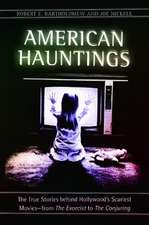Film, Faith, and Cultural Conflict: The Case of Martin Scorsese's The Last Temptation of Christ
Autor Thomas Robin Rileyen Limba Engleză Hardback – 29 sep 2003 – vârsta până la 17 ani
Preț: 362.79 lei
Preț vechi: 478.28 lei
-24% Nou
Puncte Express: 544
Preț estimativ în valută:
69.42€ • 72.67$ • 57.44£
69.42€ • 72.67$ • 57.44£
Carte tipărită la comandă
Livrare economică 05-19 aprilie
Preluare comenzi: 021 569.72.76
Specificații
ISBN-13: 9780275973575
ISBN-10: 0275973573
Pagini: 160
Dimensiuni: 156 x 235 x 18 mm
Greutate: 0.39 kg
Ediția:New.
Editura: Bloomsbury Publishing
Colecția Praeger
Locul publicării:New York, United States
ISBN-10: 0275973573
Pagini: 160
Dimensiuni: 156 x 235 x 18 mm
Greutate: 0.39 kg
Ediția:New.
Editura: Bloomsbury Publishing
Colecția Praeger
Locul publicării:New York, United States
Notă biografică
ROBIN RILEY is Assistant Professor of Electronic Media in the College-Conservatory of Music at the University of Cincinnati.
Cuprins
PrefaceIntroductionHistorical Developments in the Last Temptation ControversyDemystifying the Christian Scape GoatCountering BlasphemyProtecting Freedom of Speech: Scapegoating Religious ConservativesAppeals to Tolerance: Oprah's Presentation of the ControversyScapegoating as Legal ProcessConclusionSelected Bibliography












